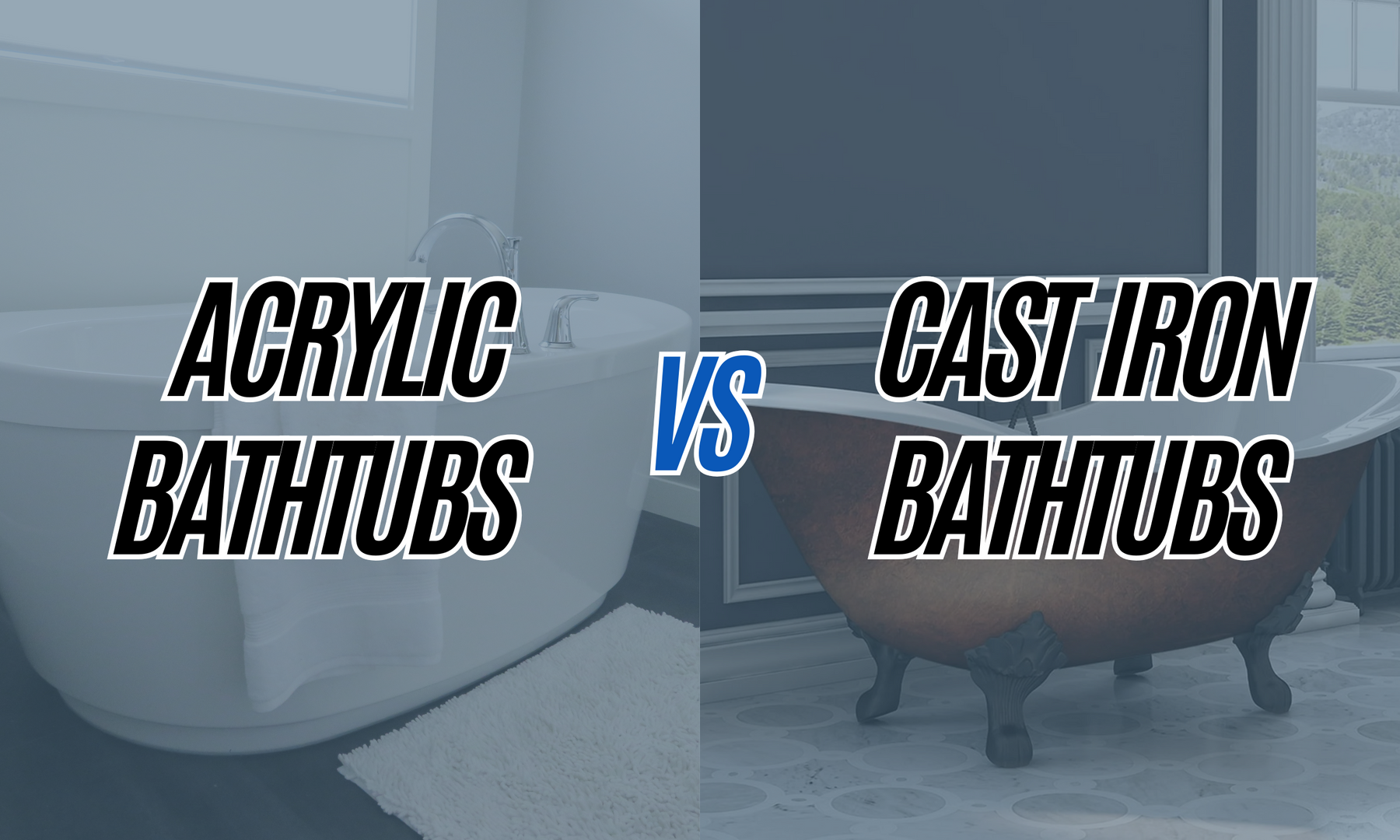

Acrylic vs. Cast Iron Tub: The Ultimate Comparison Guide
When choosing a bathtub, material is one of the most crucial factors to consider. Acrylic and cast iron are two of the most popular options, each offering distinct benefits.
To make the right decision, it’s essential to understand how these materials differ in composition, manufacturing, and performance.
Key Takeaways: Acrylic vs. Cast Iron Tub
-
Durability: Cast iron tubs last decades and resist wear, while acrylic tubs are durable but more prone to scratches.
-
Heat Retention: Cast iron retains heat much longer, keeping bathwater warm, while acrylic cools faster.
-
Weight & Installation: Acrylic tubs are lightweight and easy to install; cast iron tubs are heavy and may require reinforced flooring.
-
Maintenance: Acrylic is easy to clean but can stain; cast iron is low-maintenance but can chip if damaged.
-
Cost: Acrylic tubs are more affordable, while cast iron tubs are a premium investment.
-
Design Options: Acrylic offers more modern and ergonomic designs, while cast iron is ideal for classic, vintage aesthetics.
Bottom Line: Choose cast iron for long-term durability and luxury, or acrylic for affordability and ease of installation.
What is an Acrylic Bathtub?
Acrylic bathtubs are made from sheets of acrylic, a lightweight plastic material, reinforced with fiberglass for added strength. The result is a tub that is durable, affordable, and easy to install. Because acrylic is highly moldable, these tubs come in a wide variety of shapes, sizes, and styles, making them a popular choice for modern bathrooms.
Key Features of Acrylic Bathtubs:
Lightweight: One of the lightest bathtub materials, making installation easier.
Affordable: Generally less expensive than cast iron.
Versatile Designs: Available in many shapes, sizes, and finishes.
Warm to the Touch: The material doesn’t feel cold when first touched.
Scratch-Resistant but Softer: More prone to surface wear but can be buffed and repaired.
What is a Cast Iron Bathtub?
Cast iron bathtubs are made by pouring molten iron into a mold, which is then coated with a thick layer of porcelain enamel. This manufacturing process results in an incredibly strong, heavy, and long-lasting tub that can withstand decades of use.
Key Features of Cast Iron Bathtubs:
Extremely Durable: Built to last for decades, even with frequent use.
Superior Heat Retention: Keeps water warm longer than acrylic tubs.
Classic Aesthetic: Often seen in clawfoot designs and traditional bathrooms.
Heavy: Can weigh several hundred pounds, requiring reinforced flooring.
Scratch & Chip Resistant: The enamel coating is highly durable, but if damaged, repairs can be expensive.
Acrylic and cast iron tubs cater to different needs, whether it’s affordability and ease of installation or long-lasting durability and heat retention. In the next section, we’ll compare these two materials side by side to help you determine which one is the best fit for your bathroom.
Key Differences Between Acrylic and Cast Iron Tubs
Now that we understand the basics of acrylic and cast iron bathtubs, let’s break down their key differences. Each material has its own advantages and drawbacks, making it important to choose based on your priorities—whether it's durability, heat retention, ease of installation, or overall aesthetics.
Durability & Longevity
Cast Iron: Known for its exceptional durability, a cast iron tub can last for decades, sometimes even a lifetime. The heavy-duty iron core makes it resistant to cracks, dents, and general wear. However, the enamel coating can chip if subjected to heavy impact, though this is rare.
Acrylic: While durable, acrylic is more prone to scratches and dents over time. However, minor surface damage can often be buffed out or repaired, making maintenance easier. With proper care, an acrylic tub can still last 10–15 years, but it won't match the longevity of cast iron.
Winner: Cast iron tubs for long-term durability.
Heat Retention
Cast Iron: Superior heat retention due to its thick iron structure. Once filled, the water stays warm for an extended period, perfect for long soaking sessions.
Acrylic: While it warms up quickly, acrylic does not retain heat as well as cast iron, meaning the water cools down faster. However, using a bathtub heater or filling the tub with warm water before use can help.
Winner: Cast iron tubs for long, warm baths.
Weight & Installation
Cast Iron: Can weigh 300–500 lbs or more, making installation more challenging. Some bathrooms may need floor reinforcement to support the extra weight. Professional installation is recommended.
Acrylic: Weighs significantly less (usually 50–100 lbs), making it easy to transport, install, and even replace if needed. It’s an ideal choice for upstairs bathrooms.
Winner: Acrylic tubs for easier installation and remodeling flexibility.
Maintenance & Cleaning
Cast Iron: The enamel coating is non-porous and resistant to stains, making it easy to clean. However, if the enamel chips, repairing it can be costly.
Acrylic: Also easy to clean but can be more prone to scratches and stains over time. Harsh cleaning chemicals should be avoided to prevent damage.
Winner: Acrylic, cast iron requires extra care to prevent chipping.
Aesthetic & Design Options
Cast Iron: Offers a classic, vintage appeal, often seen in clawfoot tubs and freestanding designs. However, color options are limited, with most tubs available in traditional white or neutral tones.
Acrylic: Available in a wide range of shapes, sizes, and colors, from modern freestanding designs to alcove installations. If you want a contemporary or unique look, acrylic offers more variety.
Winner: Acrylic tubs for design variety and modern appeal.
Cost & Affordability
Cast Iron: More expensive upfront, with prices typically ranging from $1,200 to $5,000+ depending on the style and brand. However, its long lifespan can make it a worthwhile investment.
Acrylic: Budget-friendly, with tubs starting around $300 and going up to $2,000 for premium models. It's a cost-effective option for those looking for a stylish tub without breaking the bank.
Winner: Acrylic tubs for affordability.
Summary of Key Differences
|
Feature |
Acrylic Tubs |
Cast Iron Tubs |
|
Durability |
10–15 years, prone to scratches but repairable |
Can last a lifetime, extremely strong |
|
Heat Retention |
Warms up fast but loses heat quickly |
Keeps water warm for longer soaking sessions |
|
Weight |
Lightweight (50–100 lbs), easy to install |
Heavy (300–500 lbs), may need floor reinforcement |
|
Maintenance |
Easy to clean, but can stain or scratch |
Low-maintenance but enamel can chip |
|
Aesthetic |
Modern, wide variety of designs |
Classic, vintage clawfoot style |
|
Cost |
$300–$2,000 (budget-friendly) |
$1,200–$5,000+ (premium investment) |
Each material has its strengths, so the right choice depends on your specific needs. If you want an affordable, stylish, and easy-to-install bathtub, acrylic is the way to go. But if you prioritize durability, heat retention, and a timeless look, a cast iron tub is worth considering.
Acrylic Soaking Tub vs. Cast Iron: Which is Better for Relaxation?
If you love long, relaxing baths, choosing the right tub material can make a big difference. Here’s how acrylic and cast iron compare for soaking comfort:
Heat Retention: Cast iron tubs hold heat longer, keeping bathwater warm for extended periods. Acrylic cools faster but warms up quickly.
Comfort & Design: Acrylic tubs offer more ergonomic shapes and deeper soaking options. Cast iron tubs have a classic design but fewer comfort-focused features.
Noise Reduction: Cast iron absorbs sound better, making for a quieter, more spa-like bath. Acrylic tubs can be noisier but can be insulated to reduce sound.
Weight & Size: Acrylic tubs are lighter and available in larger, deeper models. Cast iron tubs are heavy, limiting their size and placement.
Which One is Better?
-
For long, warm soaks → Choose cast iron.
-
For deeper, more comfortable designs → Choose acrylic.
Both offer a great soaking experience, but the best choice depends on your priorities.
Which is Better: Cast Iron or Acrylic Bathtubs?
Now that we’ve compared durability, installation, soaking experience, and aesthetics, let’s break down which material is best for different scenarios.
Best Choice Based on Your Needs
Choose a Cast Iron Bathtub If You:
-
Want a luxury, high-end tub with a timeless look.
-
Prefer superior heat retention for long, warm baths.
-
Plan to keep the bathtub for decades and want extreme durability.
-
Have a bathroom floor strong enough to support the extra weight.
-
Are willing to invest in a higher upfront cost for a premium experience.
Choose an Acrylic Bathtub If You:
-
Want a budget-friendly tub with a stylish, modern look.
-
Need a lightweight option that’s easy to install.
-
Prefer a variety of shapes and designs for maximum comfort.
-
Want a deep soaking tub without worrying about weight restrictions.
-
Need a tub that’s easier to clean and maintain over time.
Considering Resale Value
If you’re remodeling with the intent to sell your home, cast iron tubs often add more resale value, especially in high-end markets. However, modern freestanding acrylic tubs are also attractive to buyers looking for a contemporary feel.
FAQs: Acrylic vs. Cast Iron Bathtubs
Which is better, an acrylic or cast iron bathtub?
It depends on your priorities. Cast iron is better for durability and heat retention, making it ideal for long soaks and classic aesthetics. Acrylic is lighter, easier to install, and more affordable, with greater design variety.
What are the disadvantages of acrylic tubs?
Acrylic tubs can scratch and stain more easily compared to cast iron. They also lose heat faster, requiring more hot water to maintain a warm bath. While they are durable, they typically don’t last as long as cast iron tubs.
What is the best material for a bathtub?
The best material depends on your needs. Cast iron is best for longevity and heat retention, while acrylic is ideal for those who want a lightweight, cost-effective, and stylish option. Other materials like fiberglass, stone resin, and copper offer different benefits.
What is the disadvantage of a cast iron tub?
The main downside of cast iron tubs is their weight—they can weigh 300–500 lbs, requiring reinforced flooring and professional installation. They are also more expensive upfront compared to acrylic tubs.
Conclusion: Which Tub Should You Choose?
Both cast iron and acrylic bathtubs have their strengths:
Choose cast iron if you want a long-lasting, high-quality tub that retains heat well and adds luxury to your bathroom.
Choose acrylic if you need an affordable, lightweight, and versatile tub with modern design options.
Ultimately, the right choice depends on your budget, bathroom layout, and personal preferences. Whether you prioritize comfort, cost, or durability, both materials offer excellent options for a relaxing bath experience.



